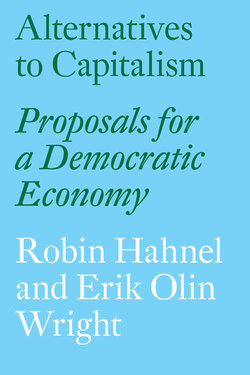Alternatives to Capitalism

Реклама. ООО «ЛитРес», ИНН: 7719571260.
Оглавление
Robin Hahnel. Alternatives to Capitalism
Praise for Alternatives to Capitalism
Alternatives to Capitalism. Proposals for a Democratic Economy. ROBIN HAHNEL. ERIK OLIN WRIGHT
Contents
INTRODUCTION. A Dialogue
CHAPTER 1. The Case for Participatory Economics
CHAPTER 2. Participatory Economics: A Sympathetic Critique
CHAPTER 3. In Defense of Participatory Economics
CHAPTER 4. Socialism and Real Utopias
CHAPTER 5. Breaking with Capitalism
CHAPTER 6. Final Thoughts
Notes
Acknowledgements
About the Authors
Отрывок из книги
“This is an extraordinary book. At one level it is a profoundly informed discussion of critical issues of radical systemic structure. At another it is a model of how a thoughtful dialogue on challenging and highly contested issues should be carried on. A must read for anyone seriously interested in how to conceive the possible forms of fundamental systemic change.”
Gar Alperovitz
.....
Here is one of the things I don’t understand about this process as described: A key issue for any meaningful planning process is the classification of the items in the consumption bundle. When a consumer submits a plan, how fine-grained are these categories? For example, is “clothing” a category, or is the relevant category “shirts,” or “dress shirts,” or “highly tailored dress shirts” or “highly tailored silk dress shirts”? Among food items, is “jam” a category, or is “imported French blueberry jam” a category? For something like “books”, is it enough to estimate how much I plan to spend on books in a year, or do I have to know which titles I am likely to buy? Also: if I travel, then my consumption of certain things will extend far beyond the boundaries of my immediate location. If I estimate how much of the value of my consumption will be in restaurants, does it matter that some of these might be in Paris or New York rather than in the city where my neighborhood consumption council is located? I can certainly imagine making gross estimates of very large categories of consumption—like clothing or travel or food—but not of fine-grained items.
The problem is that the gross categories provide virtually no useful information for the actual producers of the things I will consume. It does not help shirt-makers very much to know, based on the aggregation of individual household consumption proposals, that consumers plan to spend a certain percent of their budget on clothing; they need to have some idea of how many shirts and of what style and quality to produce since these have very different indicative prices (and thus reflect different opportunity costs and positive and negative externalities). But consumers can hardly be expected to have a reasonable idea of their consumption for the future at that level of detail—how many cheap versus expensive meals I will consume in what cities, etc. Robin does not explain how detailed the consumption list is expected to be, whether it is built on categories like “food” or the list needs to be broken down into “wild-caught smoked salmon” and “gourmet organic chunky peanut butter.” In some places he seems to suggest that the categories will be quite coarse-grained, as in the above quotation when he writes: “If one’s rate of consumption for an item deviates by say 20 percent from the rate implied by the annual request, consumers could be ‘prompted’ and asked if they want to make a change.” That prompting would make sense for a broad category like clothing, but not a detailed specification like “silk neckties”.
.....